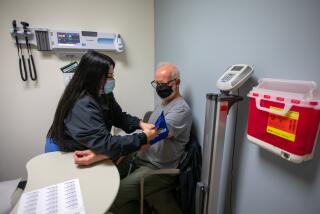He’s getting tired of bypassing life’s pleasures for a questionable increase in heart health
- Share via
Having had a cardiac artery bypass and a near-fatal arrhythmic incident, I am naturally interested in various theories about cardiac rehabilitation.
As I have noted, I am now working out three mornings a week at the Pasadena Athletic Club, under the guidance of Ray Staffanus, after a three-month period of exercises under the guidance of the cheerful young women who run the cardiac rehabilitation center at Huntington Hospital.
I am not sure, though, that pumping a stationary bicycle for 20 minutes and rowing a machine for 20 minutes is the way to a healthy heart and a long life.
Sometimes I wonder if I wouldn’t be better off if I just loafed around the house, reading and watching television and feeding the birds, which is about as much exercise as I like.
I am also not sure that my low-fat diet is making me healthier and prolonging my life. In our recent tour of Germany I stuffed myself on sausages and beer, and when we came home everyone said I looked better than when we left.
It’s partly that I don’t always believe what I read. Several years ago, long before I had the symptoms that led to my bypass, I was immortalized in the first chapter of “Type A Behavior and Your Heart,” by Dr. Meyer Friedman and Dr. Ray H. Rosenman.
Their best seller began with a quotation from this column:
“Some time ago I quit worrying about what to do, or not to do, to keep from having a heart attack. I was so confused by all the conflicting theories that I began developing the symptoms.”
The authors then went on to say: “Mr. Smith’s irritation is justified, and he is probably speaking for many Americans. ‘Don’t smoke,’ ‘don’t eat animal fat,’ ‘eat whatever you please,’ ‘watch your weight,’ ‘obesity bears no relation to heart disease,’ ‘jog,’ ‘don’t jog,’ ‘avoid cholesterol, ‘ ‘avoid sugar and starches,’ ‘avoid whiskey,’ ‘avoid sexual intercourse’--all these statements have been made at one time or another by physicians and researchers. Is it any wonder that some people figure none of us knows precisely what he is talking about?”
I was so convinced by this that none of them knew what he was talking about that I didn’t even finish reading the book, and look at me now.
Not long ago, some time after suffering my arrhythmic heart attack, I received a note from Dr. John Michael Criley of Torrance, enclosing an excerpt from a paper written by Dr. Henry W. Blackburn of the University of Minnesota, on “the disadvantages of intensive exercise therapy after myocardial infarction.”
Dr. Blackburn first describes modern man as “an animal, which, shortly after maturation, is confined to a system of special cages, in one of which, a mobile steel and plastic cage, he is exposed for one or two hours daily to complex decisions, frustration and danger, in an atmosphere high in carbon monoxide. . . .”
In this cage, Dr. Blackburn goes on, man is transported to and from other cages, in which he sits, or stands, expending very little energy, or lies motionless for three hours watching a cathode ray tube “which continuously presents ambiguous information and repeated suggestions for unhygienic, purposeless activity.”
Meanwhile, this animal eats saturated fats and refined carbohydrates, plus fermented spirits and varying concentrations of herbicides, pesticides, hormones, antibiotics, anti-oxidizing agents and radioactive isotopes.
Inevitably, Dr. Blackburn says, the poor devil experiences severe heart damage. If he survives “acute arterial insufficiency” to the heart, he is returned as soon as possible to his cages.
“Recently,” he adds, getting to the nitty-gritty, “he is placed in a special therapy cage, a humid and smelly one, along with other sick animals, and there is stressed repetitively to maximal capacity for 30 to 60 minutes daily. This stress uniformly produces ischemic and arrhythmic cardiac episodes and, on occasion, sudden death.”
He concludes:
“This new system to condition sick animals with high-level intense exercise is associated, among surviving animals, with well-documented improvement of capacity to perform physical work over a short term. It is untested with respect to the survival of animals so handled or to their future disease and disability. . . .”
So, there I am. Three times a week I am subjecting myself to stress that “uniformly produces ischemic and arrhythmic cardiac episodes and, on occasion, sudden death.”
That may be true; but I resent Dr. Blackburn’s description of the cage in which this therapy takes place as “smelly and humid.” Our room at the Pasadena Athletic Club is airy and even beautiful, with its big windows looking out on the San Gabriel Mountains. I would not call my companions in this therapy “sick animals,” either, though some of them indeed may be on thin ice. But many are young and evidently healthy.
Dr. Criley also enclosed a few suggestions from Dr. Robert Eliot of the University of Nebraska on what kind of man will never have to worry about coronary artery surgery.
Ideally, Dr. Eliot says, this lucky man would be a municipal worker or embalmer who was totally lacking in mental alertness and who has never had to meet a deadline.
He might also be a man who spurned ownership of a motor car, television set, and electrical appliances, who ate a diet of vegetables, raw fish and whale oil laced with soybean and corn oil, and who had low blood pressure, low blood cholesterol, low uric acid and a low annual income.
Somehow that doesn’t make being a man who will never have a bypass seem worthwhile.






